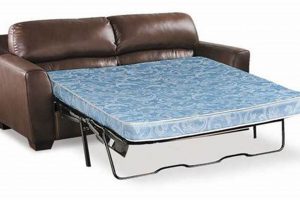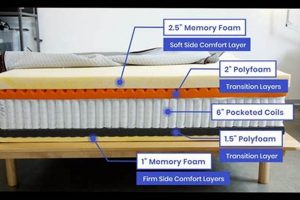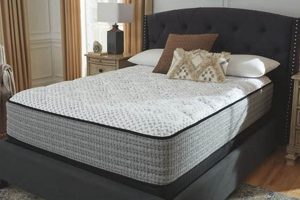The practice of exchanging the cushioning component within a convertible couch structure, specifically that which provides a sleeping surface when deployed, represents a targeted solution for improving comfort and support. This action, focused on the component that facilitates rest, aims to address issues like sagging, unevenness, or general wear and tear that commonly develop over time in multi-functional furniture. For example, a coil mattress in a pull-out couch that has lost its resilience can be substituted with a memory foam option for enhanced comfort.
Undertaking this maintenance procedure provides several advantages. It can revitalize an aging piece of furniture, extending its lifespan and delaying the need for complete replacement. Improved sleep quality is a primary benefit, addressing discomfort that can lead to restless nights. Furthermore, opting for a new component allows individuals to tailor the sleeping experience to their preferences, choosing materials and firmness levels that suit their specific needs. Historically, this type of repair has been a cost-effective alternative to purchasing new furniture, especially when the frame and mechanism of the existing unit remain functional.
Given the variety of mattresses available, and the nuances of different sleeper sofa mechanisms, careful consideration must be given to compatibility and installation. Subsequent sections will delve into the various types of replacement options, the process of measuring and selecting the appropriate size, and step-by-step instructions for a successful installation.
Essential Considerations for Sleeper Sofa Bed Mattress Replacement
Successfully navigating the process requires attention to detail and a methodical approach. The following guidelines are intended to facilitate an informed decision and a smooth execution.
Tip 1: Accurate Measurement is Crucial: Prior to initiating a purchase, meticulously measure the existing mattress dimensions (length, width, and thickness). Discrepancies can render the component unusable, leading to unnecessary returns and delays.
Tip 2: Assess the Existing Support System: Examine the underlying platform of the sleeper sofa mechanism. Sagging or damaged support structures can negate the benefits of a new mattress. Repairs or reinforcement may be necessary.
Tip 3: Material Selection Based on Intended Use: Consider the frequency of use. For occasional guests, a less expensive innerspring mattress might suffice. For regular use, memory foam or latex options offer superior comfort and durability.
Tip 4: Prioritize Compatibility with Folding Mechanism: Ensure the selected mattress is flexible enough to fold and unfold without undue stress. Overly rigid mattresses can damage the mechanism or become permanently deformed.
Tip 5: Verify Mattress Thickness Specifications: Sleeper sofa mechanisms have maximum thickness limitations. Exceeding these limits can prevent the sofa from closing properly or damage the frame.
Tip 6: Investigate Warranty Coverage: Understand the warranty terms and conditions offered by the manufacturer. A longer warranty period often indicates higher quality and provides protection against manufacturing defects.
Tip 7: Consider Professional Installation if Needed: If uncertain about the installation process, especially with complex mechanisms, seeking assistance from a qualified furniture technician is advisable.
Adherence to these recommendations contributes to a successful outcome, maximizing both comfort and the lifespan of the sleeper sofa.
The concluding section will summarize best practices and offer insights into long-term maintenance strategies.
1. Measurements
Accurate assessment of dimensions forms the foundational element for successful sleeper sofa bed mattress replacement. Imprecise dimensions inevitably lead to incompatibility and functional impairment of the convertible furniture. Meticulous measurements are not merely a preliminary step but a critical determinant of project success.
- Length and Width Accuracy
The linear dimensions of the replacement mattress must precisely match the interior frame dimensions of the sleeper sofa. Deviation, even by a fraction of an inch, can impede the folding mechanism, resulting in difficulty opening or closing the sofa bed. For example, a mattress that is slightly too long will buckle against the frame, preventing complete closure. Conversely, one that is too short will create gaps and an uneven sleeping surface.
- Thickness Compliance
The vertical dimension, or thickness, of the mattress is equally crucial. Sleeper sofa mechanisms are designed to accommodate a specific range of mattress thicknesses. Exceeding this range can strain the mechanism, potentially leading to premature failure or rendering the sofa non-functional. For instance, attempting to install a thick pillow-top mattress in a frame designed for a low-profile mattress will likely prevent the sofa from closing and may damage the frame.
- Accounting for Seam and Edge Allowance
When measuring the existing mattress or the interior frame, allow for the thickness of seams and edge binding. These seemingly minor details can cumulatively affect the overall fit. Failing to account for these can result in an underestimation of the required mattress size, leading to gaps and instability.
- Impact of Compressed vs. Uncompressed State
Mattress measurements should be taken when the existing mattress is in its uncompressed state, if possible. Over time, mattresses can compress and deform, leading to inaccurate measurements if the compressed dimensions are used. If measuring a heavily compressed mattress, consider adding a small allowance to compensate for the lost loft.
In conclusion, meticulous attention to dimensional accuracy is paramount when undertaking sleeper sofa bed mattress replacement. These measurements directly influence the functionality, comfort, and longevity of the repurposed sleeper sofa, reinforcing their indispensable role in the overall process.
2. Material Selection
The choice of materials profoundly impacts the comfort, durability, and overall suitability of a replacement mattress for sleeper sofas. The selected material dictates the sleeping experience, influences the ease of folding and unfolding the sofa mechanism, and contributes to the long-term performance of the furniture piece.
- Foam Density and Composition
Foam density directly affects the support and longevity of the mattress. High-density foams resist compression and maintain their shape over time, providing consistent support. Lower-density foams, while initially softer, tend to break down more quickly, leading to sagging and uneven sleeping surfaces. Composition, whether it be conventional polyurethane, memory foam, or latex, also plays a role. Memory foam conforms to the body’s contours, offering pressure relief, while latex provides a more resilient and supportive feel. For example, a high-density memory foam mattress offers a balance of comfort and durability suitable for frequent use, whereas a low-density polyurethane foam may be adequate for occasional guest use.
- Innerspring Coil Gauge and Count
For innerspring mattresses, the gauge (thickness) and count of the coils determine the level of support and resistance to wear. Lower gauge (thicker) coils provide firmer support, while a higher coil count distributes weight more evenly, reducing pressure points. The coil construction, such as Bonnell coils versus pocketed coils, also influences motion transfer. Pocketed coils minimize motion transfer, making them ideal for couples. An innerspring mattress with lower-gauge coils and a higher coil count is more likely to withstand the stresses of folding and unfolding without losing its shape, a critical consideration for sleeper sofas.
- Fiber Content and Quilting
The fiber content of the mattress cover and quilting affects breathability and moisture management. Natural fibers, such as cotton and wool, promote airflow and help regulate temperature, reducing the risk of overheating. Synthetic fibers, like polyester, offer durability and stain resistance. The quilting pattern also contributes to the overall comfort and appearance of the mattress. A mattress with a breathable cotton cover and a supportive quilting pattern will provide a more comfortable and hygienic sleeping environment, which is particularly important for sleeper sofas that may be used less frequently and exposed to varying conditions.
- Flame Retardant Compliance and Certifications
Adherence to flammability standards is paramount for safety. Mattresses sold in many regions must meet specific flame retardant requirements. Certifications, such as CertiPUR-US, indicate that the foam has been tested for harmful chemicals and emissions. Selecting a mattress that meets these standards ensures a safer sleeping environment. For instance, a CertiPUR-US certified memory foam mattress guarantees that it has been manufactured without ozone depleters, PBDEs, mercury, lead, and other potentially harmful substances, providing peace of mind.
In summary, the careful selection of materials in a replacement mattress directly impacts the performance and longevity of the sleeper sofa. By considering factors such as foam density, coil gauge, fiber content, and safety certifications, one can ensure that the new mattress provides optimal comfort, support, and safety for years to come, thereby enhancing the overall value and functionality of the convertible furniture.
3. Thickness Limits
The compatibility of a replacement mattress with the sleeper sofa’s folding mechanism hinges critically on adherence to designated thickness limits. This physical constraint, dictated by the structural design of the sofa bed, directly influences both the functionality of the convertible furniture and the longevity of its operating components. Exceeding the specified thickness can induce a cascade of detrimental effects, ranging from impaired closure and heightened mechanical stress to eventual structural failure. A sofa bed designed to accommodate a mattress of 5 inches in thickness, for instance, will likely experience significant resistance and potential damage if fitted with a 7-inch mattress. This incompatibility arises from the reduced internal space available for folding and storage, leading to undue pressure on hinges, levers, and the frame itself.
The practical significance of understanding thickness limitations manifests in several key areas. Firstly, adherence to these parameters prevents mechanical breakdowns and premature wear of the sleeper sofa mechanism. Forced closure due to excessive mattress thickness places disproportionate stress on the folding components, accelerating fatigue and increasing the likelihood of malfunction. Secondly, proper thickness ensures a streamlined and aesthetically pleasing appearance when the sofa is in its upright, seating configuration. A mattress that exceeds the designated thickness can cause bulging or distortion, compromising the visual appeal of the furniture piece. Thirdly, and perhaps most importantly, compliance with thickness limits guarantees the safe and reliable operation of the sofa bed, precluding scenarios where a partially opened or closed mechanism poses a safety hazard to users. Consider a situation where a family installs a mattress that is too thick. This scenario could lead to a failed mechanical action. If a child were trying to turn it into bed, it would cause potential injuries.
In conclusion, the observance of mattress thickness limits constitutes an indispensable element of successful sleeper sofa bed mattress replacement. It acts as a safeguard against mechanical damage, preserves the aesthetic integrity of the furniture, and ensures user safety. Neglecting this seemingly minor specification can have far-reaching consequences, ultimately undermining the functionality and extending the lifespan of the convertible sofa bed. Therefore, precise measurement and careful selection of a replacement mattress, with strict regard for established thickness parameters, represent a critical investment in the long-term performance and value of this multi-functional furniture item.
4. Mechanism Compatibility
Ensuring that a replacement mattress aligns seamlessly with the existing sleeper sofa mechanism is paramount for both functionality and longevity. A mismatch can result in operational difficulties, accelerated wear, and even permanent damage to the convertible furniture. The mechanical system dictates the physical constraints and operational requirements that the mattress must satisfy.
- Folding and Unfolding Range
The chosen mattress must be capable of undergoing the full range of motion required for the sofa to transition between its seating and sleeping configurations. Insufficient flexibility can impede the folding process, placing undue stress on the hinges, supports, and frame. For instance, an overly rigid mattress may prevent the sofa from closing completely, or conversely, may not fully extend into a flat sleeping surface. Such limitations not only detract from the usability of the furniture but can also compromise its structural integrity over time.
- Weight Distribution and Support
The mechanism is designed to distribute the weight of the mattress and any occupants in a specific manner. A replacement mattress that deviates significantly in weight or density from the original design can disrupt this balance. Excessive weight can overload certain components, leading to bending, warping, or outright failure. Uneven weight distribution can create pressure points, resulting in discomfort and potentially damaging the mechanism’s support structure. A coil mattress paired with a mechanism designed for foam can be disastrous.
- Clearance and Interference
The available space within the folded sofa configuration dictates the maximum permissible thickness of the mattress. Exceeding this limit can cause interference with moving parts, preventing the sofa from closing or opening smoothly. This interference can manifest as rubbing, binding, or complete blockage of the mechanism’s movement. It is imperative to verify that the replacement mattress conforms to the clearance specifications outlined in the sofa’s documentation or by the manufacturer.
- Locking and Latching Systems
Many sleeper sofas employ locking or latching systems to secure the bed in both its folded and unfolded positions. The replacement mattress must not obstruct the proper engagement of these systems. Interference can compromise the stability of the sofa in either configuration, posing a safety risk. For instance, a mattress that is too thick may prevent the latch from fully engaging, leading to the sudden collapse of the bed when occupied.
The interplay between mattress characteristics and mechanism design dictates the overall performance and lifespan of the sleeper sofa. Prioritizing compatibility during the mattress replacement process ensures seamless operation, prevents undue wear, and safeguards the structural integrity of the convertible furniture. Neglecting this critical aspect can lead to operational difficulties, costly repairs, and ultimately, premature replacement of the entire unit.
5. Support System
The structural foundation underlying the mattress within a convertible couch, frequently overlooked, significantly influences the success and longevity of the mattress replacement undertaking. A degraded or inadequate framework directly affects the performance of the newly installed component, potentially negating its intended benefits. Weakened springs, bent support bars, or a compromised platform transfer their deficiencies to the mattress, resulting in uneven support, accelerated wear, and diminished comfort. A mattress positioned upon a sagging network of springs, for instance, will conform to the underlying irregularities, creating pressure points and compromising its ability to provide adequate spinal alignment. This interaction between the support system and the mattress acts as a critical determinant of the overall sleep experience.
Evaluating and addressing the condition of the underlying structure before or during mattress replacement is therefore imperative. This evaluation may involve inspecting the springs for signs of fatigue or breakage, straightening bent support members, or reinforcing the platform with additional bracing. Real-world applications include situations where the existing wire mesh base is reinforced with plywood to prevent sagging, or when individual springs are replaced to restore uniform support. Without such interventions, the advantages of a premium-quality mattress are substantially diminished, and the expenditure on replacement risks becoming an inefficient allocation of resources. Ignoring the support system also creates a scenario where the new mattress is subjected to undue stress, shortening its lifespan and necessitating more frequent replacements.
In summary, the effectiveness of the maintenance action depends on a holistic approach that considers both the cushioning component and the structural framework. Neglecting the base compromises the investment in a new mattress, accelerates its degradation, and fails to provide the intended improvements in comfort and support. This underscores the practical significance of thoroughly assessing and, if necessary, remediating the base before installing a replacement. A strong, functional base and a new mattress is a perfect combo to deliver sleep quality.
6. Warranty
A warranty, in the context of sleeper sofa bed mattress replacement, constitutes a manufacturer’s assurance regarding the quality and durability of the product. This assurance represents a contractual obligation, whereby the manufacturer commits to repairing or replacing the mattress should it fail to meet specified performance criteria within a defined timeframe. The existence of a warranty provides consumers with recourse against premature degradation, manufacturing defects, or material flaws that compromise the intended function of the replacement mattress. For instance, a warranty might cover issues such as sagging beyond a certain threshold, coil spring failure, or seam separation. Without a warranty, consumers bear the full financial burden of addressing such issues, potentially leading to significant unanticipated costs. The presence of a comprehensive warranty is often indicative of the manufacturer’s confidence in the product’s longevity and reliability.
The scope and terms of a warranty can vary significantly across different manufacturers and product lines. Factors such as the duration of coverage, the specific defects covered, and the required documentation for claims can all impact the practical value of the warranty. Some warranties may offer full replacement during the initial years of ownership, followed by prorated coverage for subsequent years. Others may exclude specific types of damage, such as those resulting from misuse or neglect. Consumers should carefully review the warranty terms before making a purchase to ensure that the coverage adequately addresses their needs and expectations. A limited warranty that excludes common failure modes may offer little practical protection, while a comprehensive warranty provides greater peace of mind and financial security.
In summary, the warranty associated with a replacement mattress serves as a critical safeguard for consumers, providing recourse against product defects and premature failure. Understanding the terms and scope of coverage is essential for making informed purchasing decisions and maximizing the value of the investment. The inclusion of a robust warranty underscores the manufacturer’s commitment to product quality and contributes to consumer confidence in the long-term performance of the replacement mattress. Ignoring warranty implications creates vulnerability to financial consequences associated with premature product failure, underscoring the importance of this aspect within the overall replacement process.
Frequently Asked Questions
This section addresses common inquiries regarding the process of exchanging the mattress component within a sleeper sofa, providing clarity and guidance for optimal outcomes.
Question 1: How does one determine the correct size replacement mattress for a sleeper sofa?
Accurate measurement of the existing mattress or the interior frame of the sleeper sofa mechanism is paramount. Length, width, and thickness dimensions must be precisely recorded to ensure compatibility. It is advisable to account for seam allowances and compressed states when obtaining measurements.
Question 2: What mattress materials are most suitable for sleeper sofas, considering their folding mechanism?
Foam-based mattresses, particularly memory foam and latex, generally exhibit greater flexibility and resilience than traditional innerspring models. These materials readily conform to the folding contours of the mechanism while maintaining adequate support and comfort. A balance between support and flexibility is paramount.
Question 3: Can any standard mattress be used as a replacement in a sleeper sofa?
No. Standard mattresses typically exceed the thickness limitations imposed by sleeper sofa mechanisms. Attempting to install an overly thick mattress can impede the folding process, damage the mechanism, and prevent the sofa from closing properly. Adherence to specified thickness limits is critical.
Question 4: What factors should be considered when evaluating the support system beneath a sleeper sofa mattress?
Inspect the springs, support bars, and platform for signs of fatigue, bending, or breakage. A compromised support system will negatively impact the performance of the replacement mattress, leading to uneven support and accelerated wear. Reinforcement or repair of the support system may be necessary.
Question 5: How important is the warranty associated with a replacement sleeper sofa mattress?
A warranty provides protection against manufacturing defects and premature degradation. Review the warranty terms carefully, paying attention to the duration of coverage, the types of defects covered, and the claims process. A comprehensive warranty reflects the manufacturer’s confidence in the product’s quality.
Question 6: Is professional installation recommended for sleeper sofa bed mattress replacement?
Professional installation is advisable if the mechanism is complex or if the individual lacks experience with furniture repair. Improper installation can damage the mechanism or result in safety hazards. A qualified technician can ensure proper fit and function.
In conclusion, careful attention to measurement, material selection, thickness limits, support system integrity, warranty coverage, and proper installation is crucial for a successful outcome. These factors contribute to enhanced comfort, prolonged lifespan, and optimal functionality of the convertible furniture.
The following section will delve into practical tips and troubleshooting strategies for common challenges encountered during the sleeper sofa bed mattress replacement process.
Conclusion
The preceding exploration of sleeper sofa bed mattress replacement has illuminated essential aspects of this maintenance endeavor. From precise measurements and material selection to the critical evaluation of underlying support structures and warranty implications, each element plays a pivotal role in ensuring a successful outcome. The significance of mechanism compatibility and adherence to specified thickness limitations cannot be overstated, as these factors directly impact the functionality and longevity of the convertible furniture.
The replacement process is not merely an exchange of components but an opportunity to revitalize a multi-functional furniture piece, enhancing comfort, and extending its service life. Informed decision-making, coupled with meticulous execution, is paramount. Individuals are encouraged to approach this task with due diligence, recognizing that a well-executed replacement contributes to both immediate comfort and long-term value. The successful outcome of this process guarantees prolonged furniture function and contributes to sustainability, thereby promoting resource conservation.







